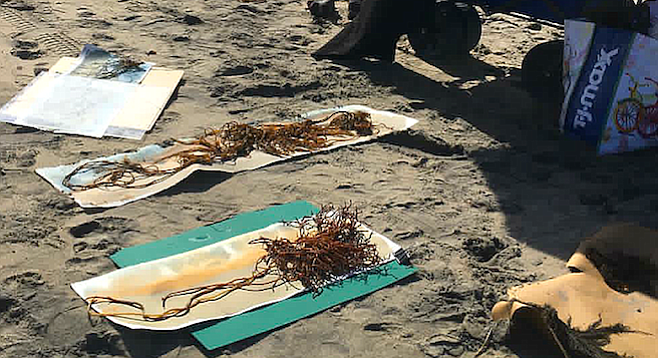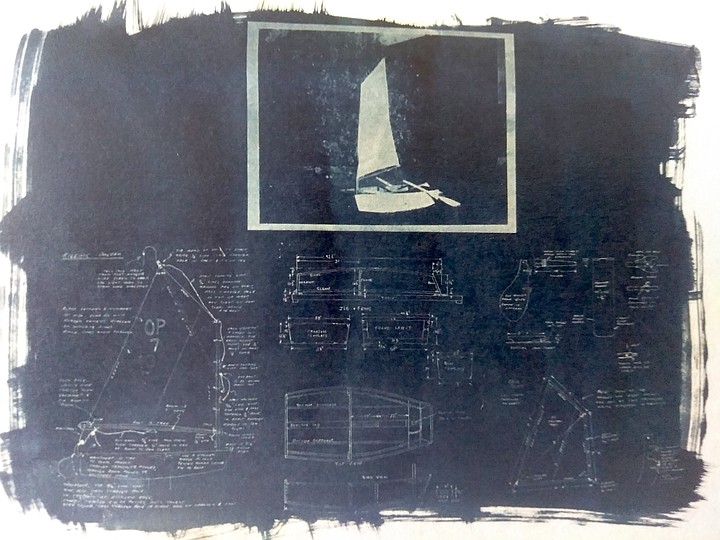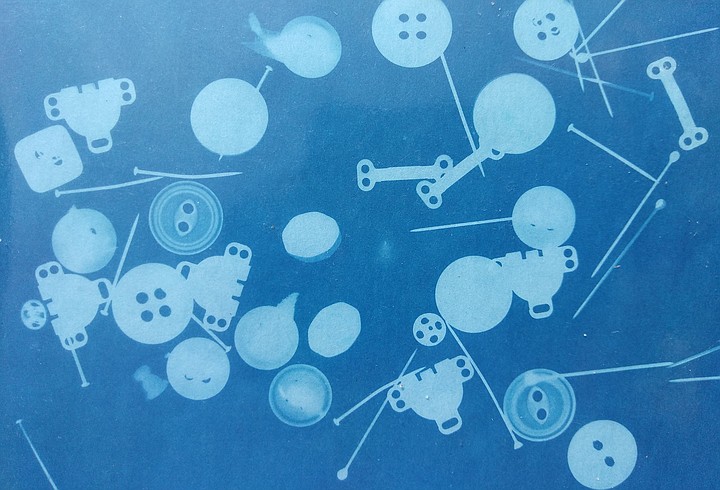 Facebook
Facebook
 X
X
 Instagram
Instagram
 TikTok
TikTok
 Youtube
Youtube

Mission Hills resident Judi Tentor has been a photographer pretty much her entire life. A few years ago she learned a new process called cyanotype photography. She talked a little about it recently as she was setting up for a student workshop in the sand at Ocean Beach.
“I took a course a few years ago at the Museum of Photographic Arts in cyanotype and I got really interested in it,” Tentor explains while showing me her work. “This was the first body of work I did. My father has Alzheimer’s and we had to empty his house and I had all these objects that I grew up with and I didn’t know what to do with, so I made these prints.”

For example, Tentor took plans for a small boat her father built in the early 1970s and transformed it into an image titled Small Boat.
Cyanotype photographic printing was invented in 1842 by an English scientist, mathematician, chemist, and astronomer named Sir John Herschel. The process produces a cyan-blue print. Engineers used the process well into the 20th Century to produce copies of drawings, now referred to as blueprints.
“The process requires that either the object or the negative be in contact with the paper,” says Tentor. “Unlike more traditional photographic processes where you can project, this is a direct process — it doesn’t have to be seaweed, I just happen to use it because Anna Atkins was a botanist and she used the process basically to duplicate her fantastic collection of seaweeds. She was also the first person to produce a photographically illustrated book with this process. Some are in the Getty Museum, I believe…. She was the reason I chose seaweed, plus to get to the beach and meet people.”

The process uses two iron salts: ferric ammonium citrate and potassium ferricyanide. The two are mixed to create the photo solution, which is brushed on, left to dry in the dark. Then objects or a negative is placed on top of the surface, exposed to UV or sunlight; the resulting image is then washed in water to develop and let dry.
“This is the paper I’m using, but you can paint the solution on anything — fabric, wood, paper… So the solution has to be painted on the paper —or whatever surface you’re using — in a dimly lit room. It doesn’t have to be 100 percent dark. And then it has to dry in the dark, then the paper is prepared….
“I keep it in here, in a light-tight envelope, and then I set this up,” she says while erecting a tent that serves as darkroom. “Because the exposures are really long compared to photographic paper, sometimes with photographic paper you get a little sliver of light and it’s exposed, but this, the exposure time is about five minutes, so it’s very forgiving in that way…”
“I feel like our world has gotten so frenetic and there’s so much research that says slowing down, connecting with nature is good for you…. Cyanotype, as a process, is really, um, becoming trendy, I guess. The Museum of Contemporary Art had an artist recently in the downtown space that had a huge wall of cyanotype.”


Mission Hills resident Judi Tentor has been a photographer pretty much her entire life. A few years ago she learned a new process called cyanotype photography. She talked a little about it recently as she was setting up for a student workshop in the sand at Ocean Beach.
“I took a course a few years ago at the Museum of Photographic Arts in cyanotype and I got really interested in it,” Tentor explains while showing me her work. “This was the first body of work I did. My father has Alzheimer’s and we had to empty his house and I had all these objects that I grew up with and I didn’t know what to do with, so I made these prints.”

For example, Tentor took plans for a small boat her father built in the early 1970s and transformed it into an image titled Small Boat.
Cyanotype photographic printing was invented in 1842 by an English scientist, mathematician, chemist, and astronomer named Sir John Herschel. The process produces a cyan-blue print. Engineers used the process well into the 20th Century to produce copies of drawings, now referred to as blueprints.
“The process requires that either the object or the negative be in contact with the paper,” says Tentor. “Unlike more traditional photographic processes where you can project, this is a direct process — it doesn’t have to be seaweed, I just happen to use it because Anna Atkins was a botanist and she used the process basically to duplicate her fantastic collection of seaweeds. She was also the first person to produce a photographically illustrated book with this process. Some are in the Getty Museum, I believe…. She was the reason I chose seaweed, plus to get to the beach and meet people.”

The process uses two iron salts: ferric ammonium citrate and potassium ferricyanide. The two are mixed to create the photo solution, which is brushed on, left to dry in the dark. Then objects or a negative is placed on top of the surface, exposed to UV or sunlight; the resulting image is then washed in water to develop and let dry.
“This is the paper I’m using, but you can paint the solution on anything — fabric, wood, paper… So the solution has to be painted on the paper —or whatever surface you’re using — in a dimly lit room. It doesn’t have to be 100 percent dark. And then it has to dry in the dark, then the paper is prepared….
“I keep it in here, in a light-tight envelope, and then I set this up,” she says while erecting a tent that serves as darkroom. “Because the exposures are really long compared to photographic paper, sometimes with photographic paper you get a little sliver of light and it’s exposed, but this, the exposure time is about five minutes, so it’s very forgiving in that way…”
“I feel like our world has gotten so frenetic and there’s so much research that says slowing down, connecting with nature is good for you…. Cyanotype, as a process, is really, um, becoming trendy, I guess. The Museum of Contemporary Art had an artist recently in the downtown space that had a huge wall of cyanotype.”
Comments